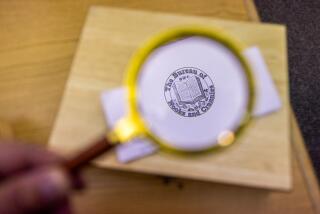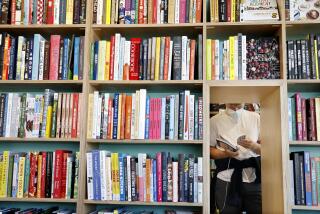Bookshelves Can Both Store and Show Off Handsome Volumes : Library: Designer finds a variety of ways to make books easily accessible for reference and reading.
- Share via
True bibliophiles can easily become overwhelmed by their collections, finding themselves frustrated by boxes of books packed away in attics or garages. Disintegration is worrisome but being cut off from a wealth of information and inspiration is torturous.
Roxann Johnson of Spatial Expressions, a total design service whose “side specialty” is built-in entertainment centers, recently encountered a client with “tons and tons” of books in storage.
“The challenge was to find a place to put them,” Johnson says. “Fortunately, the living room of the family’s Anaheim Hills home has a 20-foot-high vaulted ceiling.
“We created a library by building a railed balcony at one end of the room that extends out by 5 feet. A miniature spiral staircase leads up to walls of built-in shelves, a small seating area and a nice view as well,” Johnson says.
“When books are used and not just displayed, a nearby reading area is important,” Johnson explains. That means, at the minimum, that a chair, a table and good lighting are required. In the Anaheim Hills project, Johnson provided a cozy reading nook by extending one end of the balcony with a slight curve.
In another situation, Johnson created a handsome and substantial room divider to update a home built in the ‘60s that featured a lava-stone column by “cantilevering” bookshelves 2 inches from floor to ceiling between the columns.
In a different home, Johnson found a way to make a hallway closet do double duty. The 24-inch-deep closet backed up to a bedroom. After taking off the door and moving the back wall of the closet a foot forward, shelves were installed on both sides of the new wall, providing a double-sided bookcase accessible from either the hall or the bedroom.
Creative solutions are available for more modest book collections as well. Mini-libraries of paperbacks can be housed in the alcoves created by finishing a knocked-out portion of a wall and placing narrow shelves between the studs. Or, Johnson suggests extending the end of a kitchen countertop 12 inches and adding a row of cantilevered shelves below it to hold a collection of cookbooks.
If your book collection is sparse, art objects, plants and stereo equipment can fill in the shelf space for a practical and eye-catching display. “Just remember,” she says, “bookcases are visually heavy.” For that reason, walls of books should be offset by large pieces of furniture such as sofas.
“Books are nice, homey and sound-insulating,” says Johnson, who recommends placing bookshelves on a common walls separating a bedroom from a dining room or kitchen. For the same reason, a wall of books in a noisy family room softens sounds.
When planning a bookshelf, Johnson offers these suggestions:
Add backs to bookcases that are against outside walls or near windows to protect the books from moisture and extremes in temperatures.
Keep books away from windows and skylight because sunlight fades covers and dries pages.
When selecting finishes, Johnson notes that because painted surfaces chip and scratch easily they do not hold up well under the weight of heavy books. “The most traditional material for bookcases is wood,” she says, “but keep in mind that dark stains will show more scratches than pale finishes.”
“Melamine and laminated surfaces are more modern-looking as well as durable. For a more traditional look, add wood molding to the edges,” Johnson advises. “Or, treat wood with polyurethane to protect it.”
Johnson also recommends building bookcases slightly deeper than needed and providing low-intensity track or recessed lighting to shine on titles. “Strip lights and shelf lights are practical and attractive ways to display a fine collection,” she adds. “For small areas, heavy glass shelves that allow the light to shine through are another possibility.”
Most bookshelves measure about 1 inch thick, 12 inches deep and 30 inches wide, but allowances should be made when extra-heavy or large books need to be stored.
Provide thicker shelves or extra supports between shelves for heavy books like encyclopedias, she says. Oversized books need more “headroom” as well as a wider shelf. Mix books with lightweight accessories to avoid sagging shelves.
For those who decorate with neutral tones because they are afraid of using color, Johnson offers this advice: “Books add a nice touch of color to many otherwise bland rooms. When using books solely for effect, cover them with paper and fabrics in color and textures to suit the decor.”
If you aren’t an avid reader, but want to grace your home with the warmth and charm associated with books, an inexpensive way to gather a decorative collection is by shopping garage sales, thrift shops and used book stores.
More to Read
Sign up for our Book Club newsletter
Get the latest news, events and more from the Los Angeles Times Book Club, and help us get L.A. reading and talking.
You may occasionally receive promotional content from the Los Angeles Times.








